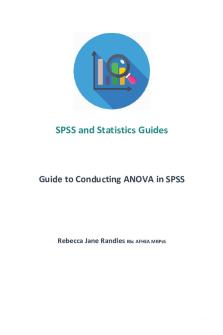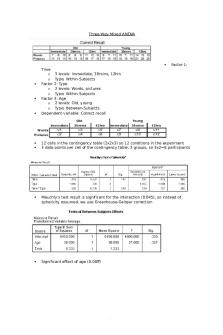Mixed Model Anova and Ancova SPSS PDF

| Title | Mixed Model Anova and Ancova SPSS |
|---|---|
| Course | Organisational Psychology: Methods and Statistics |
| Institution | University of Kent |
| Pages | 8 |
| File Size | 244.7 KB |
| File Type | |
| Total Downloads | 58 |
| Total Views | 138 |
Summary
Mixed Model Anova and Ancova ...
Description
Exercise 1 (Factorial RM ANOVA) Data for this exercise are in Repeated Measures 3.sav. This was a study about people’s attitudes toward working in different departments. Participants to the study spent a week in the marketing department, followed by a week in the sales department. They were then asked to rate their attitudes using scales measuring the affective, the cognitive, the evaluative, and the feeling dimensions. The following eight variables are all measured on 7-point scales. MA: Affective attitude (specific emotions) towards Marketing, high numbers = more positive. MC: Cognitive attitude (beliefs about health, etc.) towards Marketing, high numbers = more positive. ME: Evaluative attitude (overall good/bad) towards Marketing, high numbers = more positive. MF: Feelings attitude (general feelings) towards Marketing, high numbers = more positive. SA: Affective attitude (emotions) towards sales, high numbers = more positive. SC: Cognitive attitude (beliefs about health, etc.) towards sales, high numbers = more positive. SE: Evaluative attitude (overall good/bad) towards sales, high numbers = more positive. SF: Feelings attitude (general feelings) towards sales, high numbers = more positive. Between participants variables are: Sex: 1 if male, 2 if female. Qorder: Whether different type of attitudes: affect (1), cognitive (2), evaluative (3) or feelings (4) was presented first in each questionnaire, with the others following in that order. Dvorder: Whether attitudes toward marketing (1) or sales (2) was measured first. Training: 1 if the person had undergone training in the previous 150 days, 2 if not.
a. For this exercise, include all kinds of attitudes in your analysis, but choose two different between subjects independent variables – one being either sex or training, the other being either qorder or dvorder.
4 (attitude: affective, cognitive, evaluative and feelings) x 2 (department: marketing and sales) x 2 (training: undergone training in previous 150 days and had not) x 2 (dvorder: marketing measured first and sales measured first) mixed-model ANOVA
b. Run a mixed-model ANOVA crossing all four of your factors. In Options ... request estimated marginal means for all main effects and, to keep things simple for now, two-way interactions only (This will give you means across levels of within-subject factors, something that descriptives does not do). Report all significant and marginal effects in text format. (In a large ANOVA like this you can sometimes get away with saying, "All other effects were nonsignificant, p > .10" – especially if your arguments do not rest on those effects being nonsignificant). (To make a plot: add within subject factor as “separate lines”)
A 4 x 2 x 2 x 2 mixed-model ANOVA was conducted to compare the main effects of attitude, department, training and attitude measured first and their interactions. Sphericity was violated on attitude and the interaction between attitude and department, therefore the Greenhouse-Guisser correction was used. The main effect of attitude was significant (F(1.385,91.407) = 12.82, p = .000), however the main effect of department was non-significant (p = .859). Attitude insignificantly interacted with training (p = .279) and dvorder (p = .355). All department effects were non-significant (p > .10). Attitude and department significantly interacted, F(2.408, 128.931) = 27.36, p = .000.
c. Looking at your marginal means, how would you describe those main effects and two-way interactions (only!) that came out significant? Interpret the results. Attitude main effect significant: Affective attitude was significantly lower (M = 4.55, SD = .10) than cognitive (M = , SD = ), feelings (M = , SD = ) and evaluative (M = , SD = ).
Attitude and training significant interaction: For participants who were trained in the last 150 days, affective attitude was lowest (M = , SD = ) and evaluative was the highest (M = , SD = ). The same pattern for those who were not trained in the last 140 days … More to write…
Exercise 2 (ANCOVA) Select: analyse, general linear model, univariate. List Affective attitude as the DV, SEX and Training as IV, and COGNITIVE ATTITUDES as covariate. Click the options button and select descriptives, estimates of effect size, and display means. Looks at whether there is a significant difference in DV affective attitude between sex and training, once their means are adjusted for cognitive attitude i.e. holding cognitive attitude constant.
a.
Look at the output, did the covariate had a significant effect?
b. Write a brief paragraph, summarizing the findings from the ANCOVA.
Exercise 3 (Factorial ANOVA) Factorial ANOVA using GLM and simple effect tests These data are from the European Social Survey, a data set made up of British (GB), Swiss (CH) and Norwegian (NO) respondents, and saved as ANCOVA_ESS.sav. You are going to explore the complicated interactions between country, marital status and work status by means of factorial GLM/ANOVA and simple effects tests. Although this is a three-way ANOVA, the principles are the same as for the two-way example.
Relevant variables are:
Country: British (GB), Swiss (CH) and Norwegian (NO) Marital3: A marital/civil partnership status variable that is 1 for never, 2 for currently, 3 for formerly (including divorced, separated, widowed) Work: Whether they have not (0) or have (1) done paid work in the last 7 days. Happy: Happiness in general, 0-10, high numbers = more happy. Lrscale: Identification as left (0) or right (10) wing, politically . Eduyrs: Number of years of education. First we will look at how country, marital status and work status interact to predict lrscale.
a. Report the results of a three-way ANOVA with country, marital3, and work as IVs, and lrscale as your DV. Obtain, but do not report, cell means (descriptive statistics). Comment on the effect sizes (are they conventionally small, medium, large?)
b. To explain this interaction, do simple effects tests of the effect of marital status on your DV for each combination of nation and work. To save time, report only those omnibus tests that are significant (for example, if the effect of marital3 is significant for only for nonworkers from a certain nation, you should report this). Within each significant omnibus test, report any comparisons that are significant between pairs of levels of marital (for example, between married and formerly married). You need only report the pairs that are significantly different and their p values.
Exercise 4 (ANCOVA)
We want to see whether these results still obtain with eduyrs as a covariate, because it might be related to political orientation. We are going to focus on the marital3 x work interaction, ignoring country.
a. Run a correlation analysis to see whether the covariate of education is related to political orientation and report and interpret the results.
b. Run a factorial GLM with marital3 and work as IVs and the covariate, eduyrs, as DV. Report the main and interaction effects of this analysis. Do the results indicate that the covariate will have a confounding or an error effect?
c. Now run and report an analysis of covariance with your DV, the two IVs, and eduyrs as covariate. Compared to your previous GLM results, did any of the effects lose significance when the covariate was accounted for?
d.
Examining the estimated (adjusted) means, which marginal means changed the most compared to the unadjusted means? Relate this to the effects of the covariate....
Similar Free PDFs

Factorial Anova SPSS example
- 12 Pages

Repeated Measures Anova SPSS
- 4 Pages

Laporan ANOVA SPSS
- 23 Pages

ANOVA Analysis in SPSS
- 12 Pages

7) Three-Way Mixed Anova
- 3 Pages

Ancova
- 4 Pages

ANCOVA SEDERHANA
- 1 Pages

3rd and Mixed Conditionals
- 2 Pages
Popular Institutions
- Tinajero National High School - Annex
- Politeknik Caltex Riau
- Yokohama City University
- SGT University
- University of Al-Qadisiyah
- Divine Word College of Vigan
- Techniek College Rotterdam
- Universidade de Santiago
- Universiti Teknologi MARA Cawangan Johor Kampus Pasir Gudang
- Poltekkes Kemenkes Yogyakarta
- Baguio City National High School
- Colegio san marcos
- preparatoria uno
- Centro de Bachillerato Tecnológico Industrial y de Servicios No. 107
- Dalian Maritime University
- Quang Trung Secondary School
- Colegio Tecnológico en Informática
- Corporación Regional de Educación Superior
- Grupo CEDVA
- Dar Al Uloom University
- Centro de Estudios Preuniversitarios de la Universidad Nacional de Ingeniería
- 上智大学
- Aakash International School, Nuna Majara
- San Felipe Neri Catholic School
- Kang Chiao International School - New Taipei City
- Misamis Occidental National High School
- Institución Educativa Escuela Normal Juan Ladrilleros
- Kolehiyo ng Pantukan
- Batanes State College
- Instituto Continental
- Sekolah Menengah Kejuruan Kesehatan Kaltara (Tarakan)
- Colegio de La Inmaculada Concepcion - Cebu







